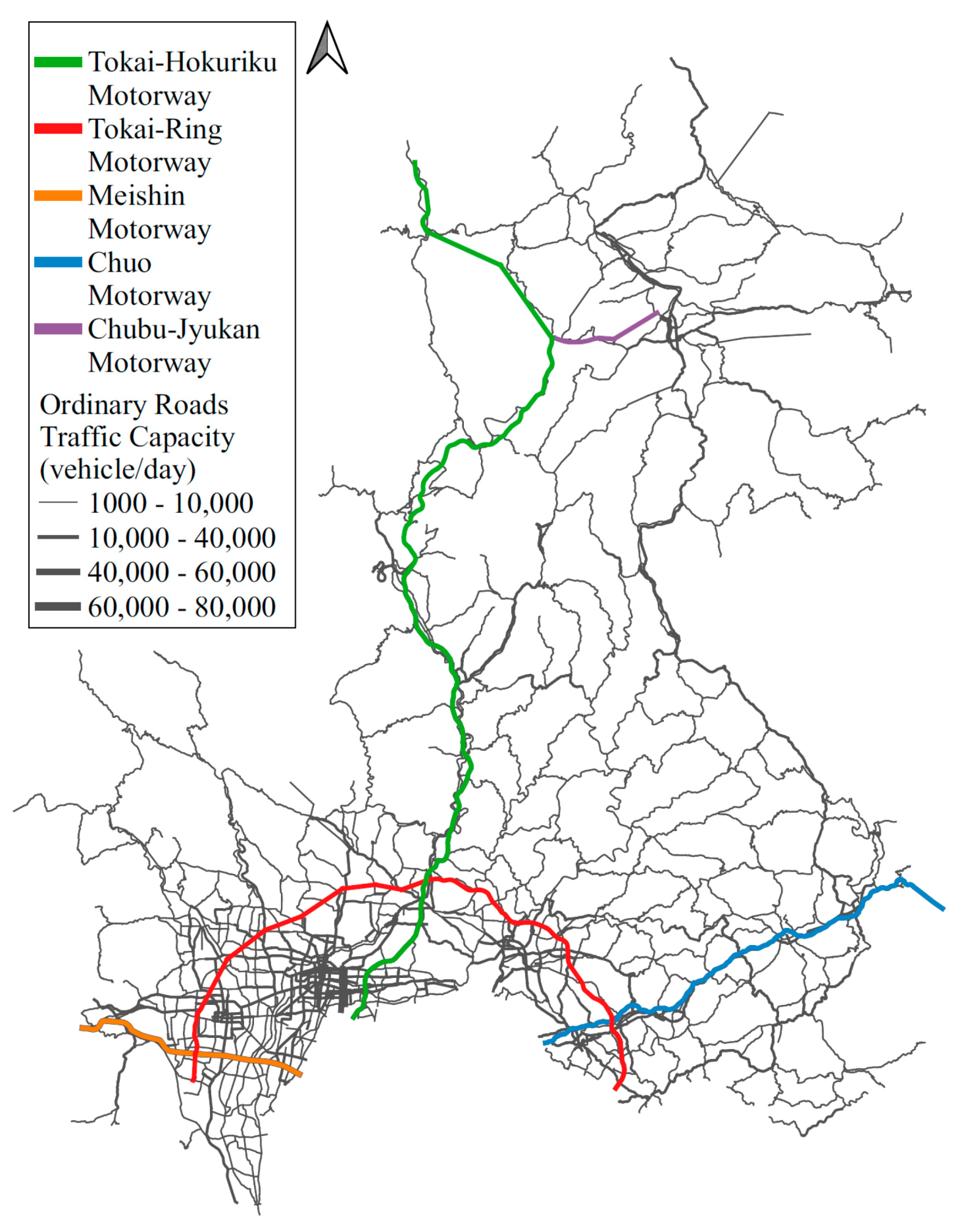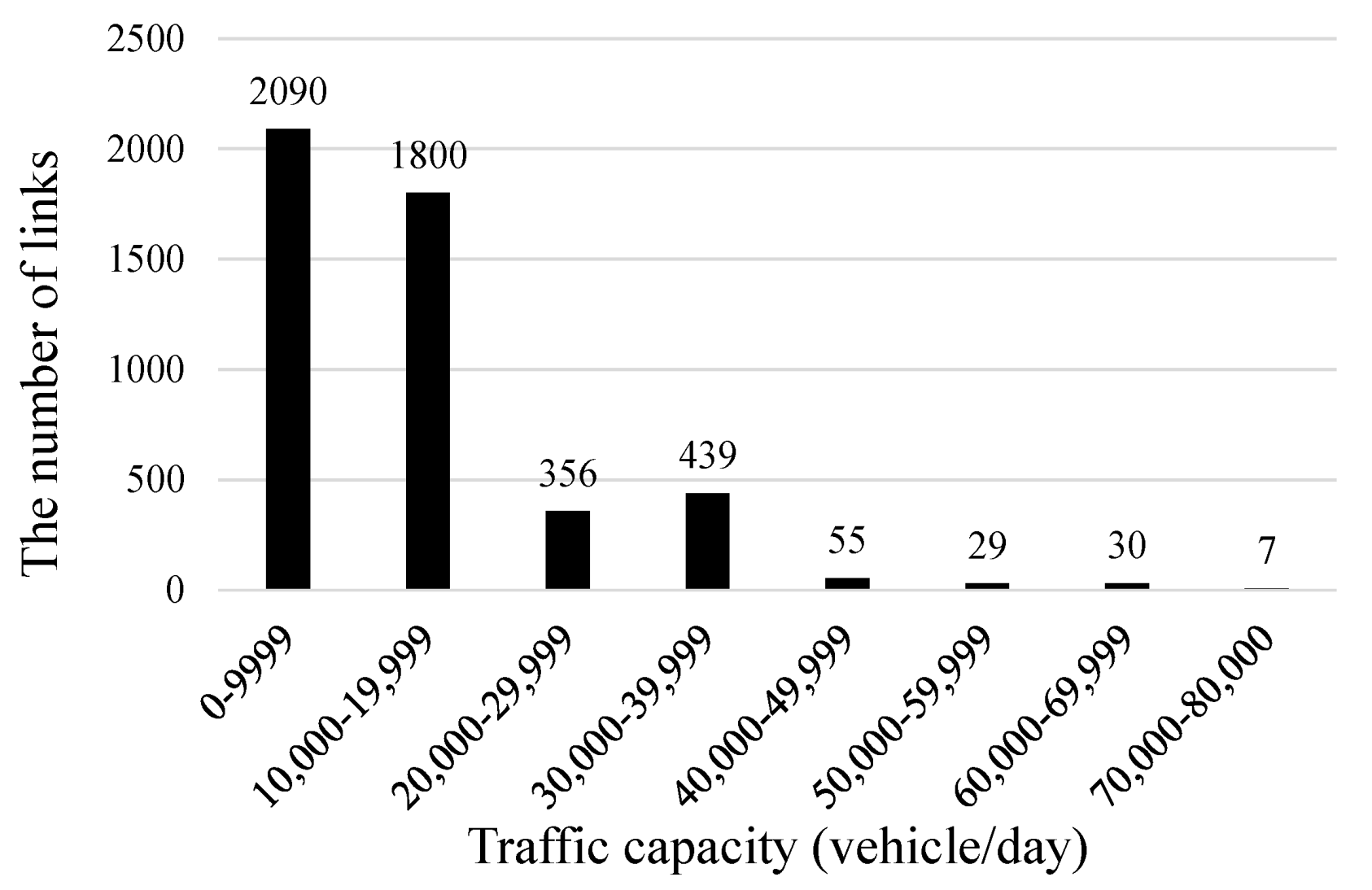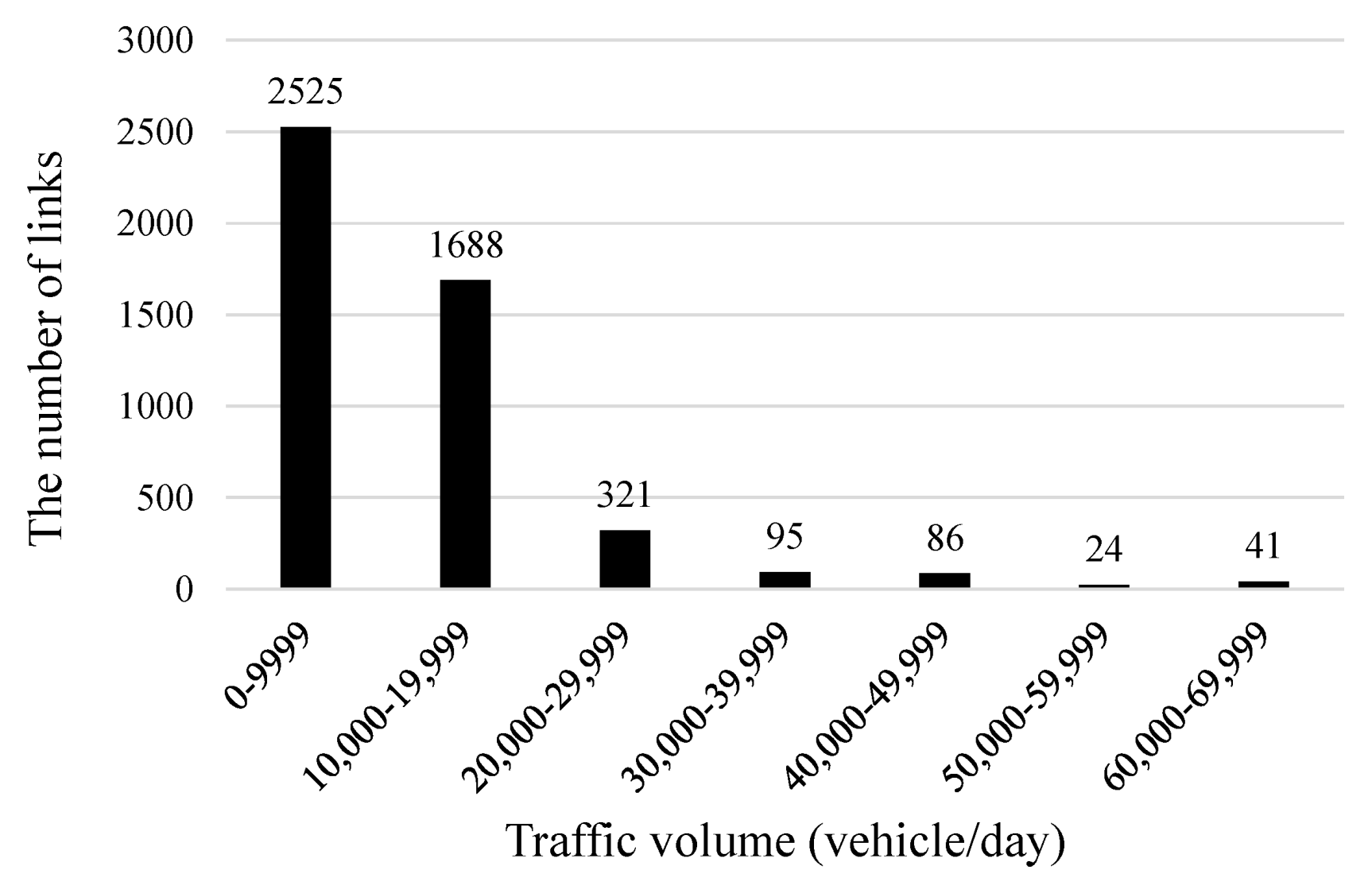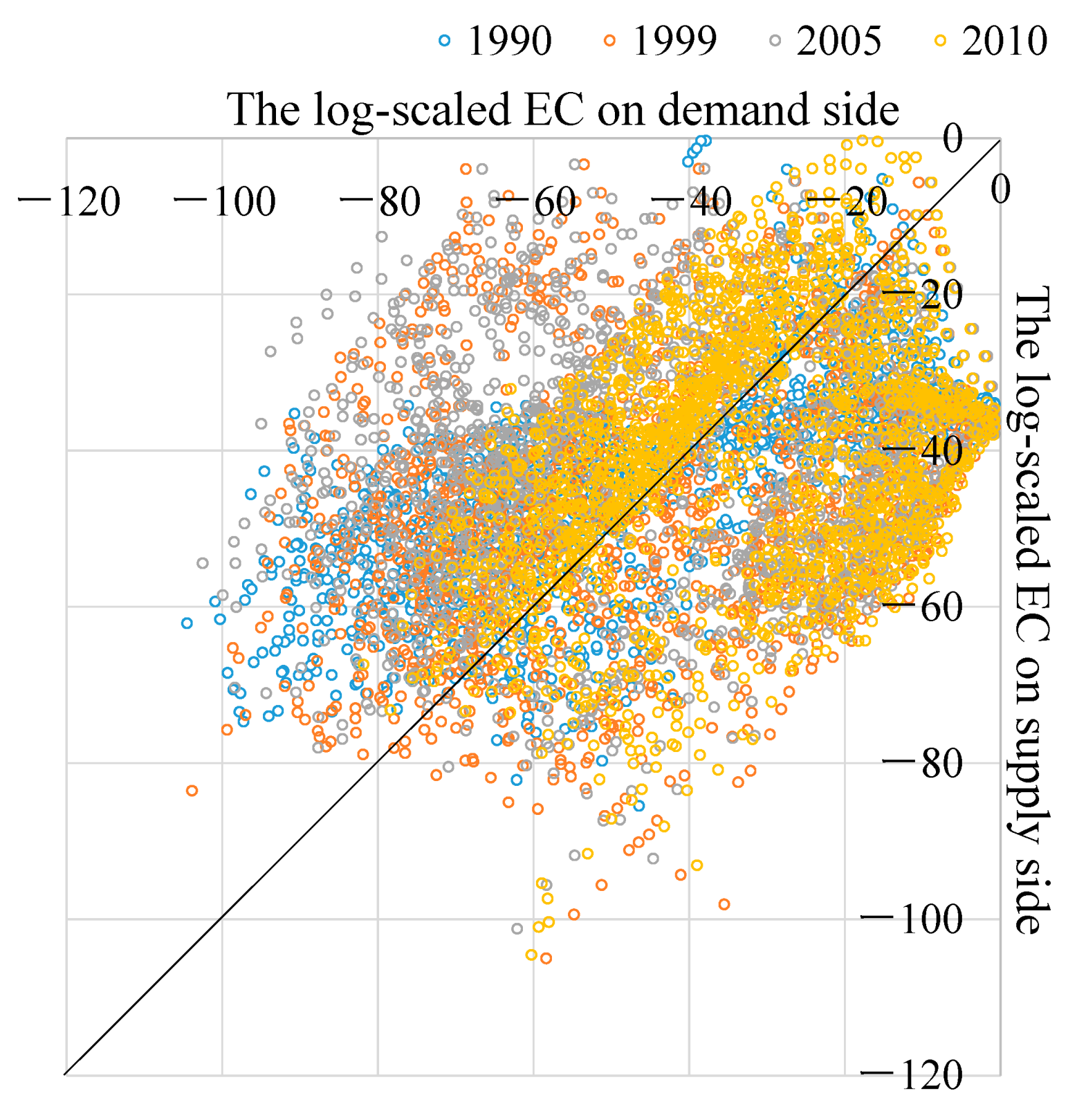How Does Travel Demand Follow the Change in Infrastructure? Multiple-Year Eigenvector Centrality Analysis
Abstract
:1. Introduction
2. Literature Review
2.1. Land Use and Transportation Interaction Model
2.2. Network Analysis by Topological Approach
3. Methodology
3.1. Eigenvector Centrality
- is irreducible if and only if is irreducible;
- is positive if and only if is positive for all
- is the number of directed paths of length starting at and ending at .
- is irreducible.
- for all .
- There is a directed path in of length at most starting at and ending at for all .
- There is a directed path in starting at and ending at for all . □
3.2. Weight Setting
4. Target Area for Analysis and Traffic Data Used
4.1. Road Improvement History in Gifu Prefecture
4.2. Survey Data of Roads
5. Impacts of Road Network Improvements
6. Relationship between Supply and Demand
7. Conclusions
Author Contributions
Funding
Institutional Review Board Statement
Informed Consent Statement
Data Availability Statement
Conflicts of Interest
References
- Research Report: Study on Personal Passenger Car Traffic Regulation Following the Great Earthquake Disaster. Int. Assoc. Traffic Saf. Sci. 2002, 23, 3. (In Japanese)
- Cutini, V.; Pezzica, C. Street network resilience put to the test: The dynamic crash of Genoa and Bologna bridges. Sustainability 2020, 12, 4706. [Google Scholar] [CrossRef]
- Wegener, M. Operational urban models state of the art. J. Am. Plan. Assoc. 1994, 60, 17–29. [Google Scholar] [CrossRef]
- Iacono, M.; David, L.; Ahmed, E.G. Models of transportation and land use change: A guide to the territory. J. Plan. Lit. 2008, 22, 323–340. [Google Scholar] [CrossRef]
- Forrester, J.W. Urban dynamics. IMR Ind. Manag. Rev. 1970, 11, 67. [Google Scholar] [CrossRef] [Green Version]
- Wegener, M. Overview of land use transport models. In Handbook of Transport Geography and Spatial Systems; Emerald Group Publishing Limited: Bingley, UK, 2004; Volume 9, pp. 127–146. [Google Scholar]
- Hunt, J.D.; Kriger, D.S.; Miller, E.J. Current operational urban land use–transport modelling frameworks a review. Transp. Rev. 2005, 25, 329–376. [Google Scholar] [CrossRef]
- Kii, M.; Nakanishi, H.; Nakamura, K.; Doi, K. Transportation and spatial development: An overview and a future direction. Transp. Policy 2016, 49, 148–158. [Google Scholar] [CrossRef]
- Alonso, W. Location and Land Use; Harvard University Press: Cambridge, UK, 1964. [Google Scholar]
- Herbert, J.D.; Stevens, B.H. A Model for the distribution of residential activity in urban areas. J. Reg. Sci. 1960, 2, 21–36. [Google Scholar] [CrossRef]
- Fujita, M. Urban Economic Theory; Cambridge University Press: Cambridge, UK, 1989. [Google Scholar]
- Anas, A. Residential Location Markets and Urban Transportation, Economic Theory, Econometrics and Policy Analysis with Discrete Choice Models; Academic Press Inc.: London, UK, 1982. [Google Scholar]
- Lowry, I.S. A Model of Metropolis; Rand Corp: Santa Monica, CA, USA, 1964. [Google Scholar]
- Anas, A.; Arnott, R.; Small, K.A. Urban spatial structure. J. Econ. Lit. 1998, 36, 1426–1464. [Google Scholar]
- Salvani, P.; Miller, E.J. ILUTE: An operational prototype of a comprehensive microsimulation model of urban systems. Netw. Spat. Econ. 2005, 5, 217–234. [Google Scholar] [CrossRef]
- Musolino, G. Modelling long-term impacts of the transport supply system on land use travel demand in urban areas. Eur. Transp. 2008, 40, 69–87. [Google Scholar]
- Wegener, M. Integrated land-use transport modelling progress around the globe. In Proceedings of the Fourth Oregon Symposium on Integrated Land-Use Transport Models, Portland, OR, USA, 13–16 July 2005; pp. 15–17. [Google Scholar]
- Patarasuk, R.; Binford, M.W. Longitudinal analysis of the road network development and land-cover change in Lop Buri province, Thailand, 1989–2006. Appl. Geogr. 2012, 32, 228–239. [Google Scholar] [CrossRef]
- Santos, B.; Antunes, A.; Miiler, E.J. Integrating equity objectives in a road network design model. Transp. Res. Rec. 2008, 2089, 35–42. [Google Scholar] [CrossRef] [Green Version]
- Garrison, W.L. Connectivity of the interstate highway system. Reg. Sci. Assoc. Pap. Proc. 1960, 6, 121–137. [Google Scholar] [CrossRef]
- Garrison, W.L.; Marble, D.F. The Structure of Transportation Networks; Technical Report 62; U.S. Army Transportation Command: Scott Air Force Base, IL, USA, 1962; pp. 73–88. [Google Scholar]
- Kansky, K. Structure of Transportation Networks: Relationships between Network Geometry and Regional Characteristics. Doctoral Dissertation, Department of Geography, University of Chicago, Chicago, IL, USA, 1963. [Google Scholar]
- Haggett, P.; Chorley, R.J. Network Analysis in Geography; Edward Arnold: London, UK, 1969; p. 56. [Google Scholar]
- Medvedkov, Y.V. An application of topology in central place analysis. Pap. Proc. Reg. Sci. 1968, 20, 77–84. [Google Scholar] [CrossRef]
- Royaltey, H.H.; Astrachan, E.; Sokal, R.R. Tests for patterns in geographic variation. Geogr. Anal. 1975, 7, 369–395. [Google Scholar] [CrossRef]
- Xie, F.; Levinson, D. Measuring the structure of road networks. Geogr. Anal. 2007, 39, 336–356. [Google Scholar] [CrossRef]
- Latora, V.; Marchiori, M. Efficient behavior of small-world networks. Phys. Rev. Lett. 2001, 87, 198701. [Google Scholar] [CrossRef] [Green Version]
- Bavelas, A. A mathematical model for group structures. Appl. Anthropol. 1949, 7, 16–30. [Google Scholar] [CrossRef]
- Newman, M.E.J. Networks; Oxford University Press: Oxford, UK, 2010. [Google Scholar]
- Morgado, P.; Costa, N. Graph-based model to transport networks analysis through GIS. In Proceedings of the European Colloquium on Quantitative and Theoretical Geography, Athens, Greece, 2–5 September 2011. [Google Scholar]
- Erath, A.; Lochl, M.; Axhausen, K.W. Graph-theoretical analysis of the swiss road and railway networks over time. Netw. Spat. Econ. 2009, 9, 379–400. [Google Scholar] [CrossRef] [Green Version]
- Casali, Y.; Heinimann, H.R. A topological analysis of growth in the Zurich road network. Comput. Environ. Urban Syst. 2019, 75, 244–253. [Google Scholar] [CrossRef]
- Lämmer, S.; Gehlsen, B.; Helbing, D. Scaling Laws in the Spatial Structure of Urban Road Networks. Phys. A Stat. Mech. Its Appl. 2006, 363, 89–95. [Google Scholar] [CrossRef] [Green Version]
- Duan, Y.; Lu, F. Robustness of city road networks at different granularities. Phys. A Stat. Mech. Its Appl. 2004, 411, 21–34. [Google Scholar] [CrossRef]
- Jiang, B.; Claramunt, C. A Structural Approach to the Model Generalization of an Urban Street Network. Geoinformatica 2004, 8, 157–171. [Google Scholar] [CrossRef]
- Crucitti, P.; Latora, V.; Porta, S. Centrality in networks of urban streets. Phys. Rev. E 2006, 73, 036125. [Google Scholar] [CrossRef] [PubMed] [Green Version]
- Porta, S.; Crucitti, P.; Latora, V. Multiple centrality assessment in Parma: A network analysis of paths and open spaces. Urban Des. Int. 2008, 13, 41–50. [Google Scholar] [CrossRef] [Green Version]
- Proctor, C.H.; Loomis, C.P. Analysis of sociometric data. In Research Methods in Social Relations; Holland, P.W., Leinhardt, S., Eds.; Dryden Press: New York, NY, USA, 1951; pp. 561–586. [Google Scholar]
- Bonacich, P. Factoring and weighting approaches to status scores and clique identification. J. Math. Sociol. 1972, 2, 113–120. [Google Scholar] [CrossRef]
- Beauchamp, M.A. An improved index of centrality. Behav. Sci. 1965, 10, 161–163. [Google Scholar] [CrossRef]
- Freeman, L. A set of measures of centrality based on betweenness. Sociometry 1977, 40, 35–41. [Google Scholar] [CrossRef]
- Katz, L. A New Status Index Derived from Sociometric Analysis. Psychometrika 1953, 18, 39–43. [Google Scholar] [CrossRef]
- Brin, S.; Page, L. The anatomy of a Large-Scale hypertextual web search engine. In Proceedings of the Seventh International World-Wide Web Conference, Brisbane, Australia, 12–18 April 1998; pp. 107–117. [Google Scholar]
- Martin, T.; Zhang, X.; Newman, M.E. Localization and centrality in networks. Phys. Rev. E 2014, 90, 052808. [Google Scholar] [CrossRef] [Green Version]
- Barabasi, A.; Bonabeau, E. Scale-Free networks. Sci. Am. 2003, 288, 50–59. [Google Scholar] [CrossRef]
- Bihari, A.; Pandia, M.K. Key author analysis in research professionals’ relationship network using citation indices and centrality. Procedia Comput. Sci. 2015, 57, 606–613. [Google Scholar] [CrossRef] [Green Version]
- Borgatti, S.P. Centrality and network flow. Soc. Netw. 2005, 27, 55–71. [Google Scholar] [CrossRef]
- Landherr, A.; Friedl, B.; Heidemann, J. A critical review of centrality measures in social networks. Busines Inf. Syst. Eng. 2019, 2, 371–385. [Google Scholar] [CrossRef]
- Ando, H.; Bell, M.; Kurauchi, F.; Wong, K.I.; Cheung, K.F. Connectivity evaluation of large road network by capacity-weighted eigenvector centrality analysis. Transp. A Transp. Sci. 2021, 17, 648–674. [Google Scholar] [CrossRef]
- Cheung, K.F.; Bell, M.G.; Pan, J.J.; Perera, S. An eigenvector centrality analysis of world container shipping network connectivityk. Transp. Res. Part E 2020, 140, 101991. [Google Scholar] [CrossRef]
- Gifu Prefecture. Japan Official Homepage. Available online: https://www.pref.gifu.lg.jp/site/english/ (accessed on 15 October 2021).








| Centrality Measures | Formulation | Definition |
|---|---|---|
| Degree Centrality | The number of links connected to the node | |
| Closeness Centrality | A reciprocal of the average distance from a node to all other nodes using the shortest path | |
| Betweenness Centrality | The extent to which a node lies on the shortest paths between other nodes | |
| Eigenvector Centrality | The importance of a node in a network is increased by having connections to other nodes that are themselves important |
| Year | Tokai-Hokuriku Motorways | Tokai-Ring Motorways |
|---|---|---|
| 1986 | Opened Gifu-KakamigaharaIC~MinoIC L = 19.1 km (4 Lanes) | |
| 1992 | Opened FukumitsuIC~Oyabe-TonamiJCT L = 11.1 km (2 Lanes) | |
| 1994 | Opened MinoIC~MinamiIC L = 17.2 km (2 Lanes) | |
| 1996 | Opened MinamiIC~Gujo-HachimanIC L = 10.2 km (2 Lanes) | |
| 1997 | Opened Ichinomiya-KisogawaIC~Gifu-KakamigaharaIC L = 5.6 km (4 Lanes) Opened Gujo-HachimanIC~ShirotoriIC L = 16.6 km (2 Lanes) | |
| 1998 | Opened BisaiIC~Ichinomiya-KisogawaIC L = 3.8 km (4 Lanes) Opened IchinomiyaJCT~BisaiIC L = 3.9 km (4 Lanes) | |
| 1999 | Opened ShirotoriIC~ShokawaIC L = 21.9 km (2 Lanes) | |
| 2000 | Opened GokayamaIC~FukumitsuIC L = 16.3 km (2 Lanes) Opened ShokawaIC~Hida-KiyomiIC L = 18.9 km (2 Lanes) | |
| 2002 | Opened ShirakawagoIC~GokayamaIC L = 15.2 km (2 Lanes) | |
| 2004 | 4 Lanes completed MinoIC~Fukubegatake PA L = 18.5 km South from ShirotoriIC L = 2.1 km | |
| 2005 | Opened Toyota-Higashi JCT~Mino-Seki JCT L = 73.0 km | |
| 2007 | Hida tunnel opened | |
| 2008 | Opened Hira-Kiyomi IC~Shirakawago IC L = 25.0 km (2 Lanes) [ALL Lanes opened] 4 Lanes completed Fukubegatake PA~Gujo-HachimanIC L = 8.9 km | |
| 2009 | 4 Lanes completed Gifu-YamatoIC~ShirotoriIC L = 10.4 km 4 Lanes completed Gujo-Hachiman IC~Gifu-YamatoIC L = 6.2 km | Opened Mino-Seki JCT~Seki-Hiromi IC L = 2.9 km |
| 2012 | Opened Ogaki-Nishi IC~Yoro JCT L = 5.7 km | |
| 2016 | Opened ToinIC~Shin-Yokkaichi JCT L = 1.4 km | |
| 2017 | Opened Yoro JCT~Yoro IC L = 3.1 km | |
| 2018 | 4 Lanes completed Shirotori IC~Takasu IC L = 8 km 4 Lanes completed Hirugano-Kougen SA~Hida-Kiyomi IC L = 26 km | |
| 2019 | 4 Lanes completed Takasu IC~Hirugano-Kogen SA L = 7 km | Opened DaianIC~ToinIC L = 6.4 km Opened Ohno-GodoIC~OgakinishiIC L = 7.6 km |
| 2020 | Opened Seki-HiromiIC~YamagataIC L = 9.0 km |
| Year | 1990 | 1999 | 2005 | 2010 |
|---|---|---|---|---|
| Node | 1727 | 1770 | 1791 | 1793 |
| Link (general) | 4494 | 4618 | 4717 | 4723 |
| Link (motorway) | 35 | 52 | 69 | 73 |
| Supply | |||||
|---|---|---|---|---|---|
| Year | 1990 | 1999 | 2005 | 2010 | |
| Demand | 1990 | 0.720 | 0.300 | 0.140 | 0.131 |
| 1999 | 0.715 | 0.289 | 0.154 | 0.140 | |
| 2005 | 0.728 | 0.289 | 0.157 | 0.143 | |
| 2010 | 0.764 | 0.478 | 0.361 | 0.349 | |
Publisher’s Note: MDPI stays neutral with regard to jurisdictional claims in published maps and institutional affiliations. |
© 2021 by the authors. Licensee MDPI, Basel, Switzerland. This article is an open access article distributed under the terms and conditions of the Creative Commons Attribution (CC BY) license (https://creativecommons.org/licenses/by/4.0/).
Share and Cite
Ando, H.; Kurauchi, F. How Does Travel Demand Follow the Change in Infrastructure? Multiple-Year Eigenvector Centrality Analysis. Sustainability 2021, 13, 13366. https://doi.org/10.3390/su132313366
Ando H, Kurauchi F. How Does Travel Demand Follow the Change in Infrastructure? Multiple-Year Eigenvector Centrality Analysis. Sustainability. 2021; 13(23):13366. https://doi.org/10.3390/su132313366
Chicago/Turabian StyleAndo, Hiroe, and Fumitaka Kurauchi. 2021. "How Does Travel Demand Follow the Change in Infrastructure? Multiple-Year Eigenvector Centrality Analysis" Sustainability 13, no. 23: 13366. https://doi.org/10.3390/su132313366
APA StyleAndo, H., & Kurauchi, F. (2021). How Does Travel Demand Follow the Change in Infrastructure? Multiple-Year Eigenvector Centrality Analysis. Sustainability, 13(23), 13366. https://doi.org/10.3390/su132313366






